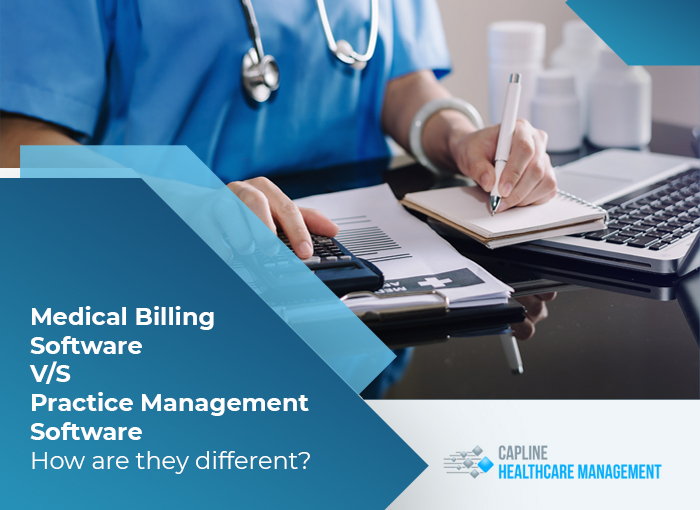Medical Billing Software vs. Practice Management Software- How are they different?
Every healthcare practice needs the plan to reach its goals. Some practices strive for efficiency to be better, while others want to streamline the claim processing to avoid losses. Many practices want to communicate with their patients thoroughly by notifying them about their bills, appointments, etc. Today, we have practices that prefer outsourcing backend functions such as medical billing services to maintain a positive cash flow. Approaches can vary, but they all lead to a common goal- growth.
Every practice has a right to proceed as they deem fit, but when buying a Medical Billing System or Practice Management Software, remember that you are also responsible for the lives and health of others. That is why it is critical to understand the significant differences between the subtleties of medical billing and medical practice management software.
The debate over medical billing vs. practice management software is also a significant source of confusion for most. These two may appear similar to a layperson but are very different in the workflow. As a result, the focus of this article will be on the significant differences in the operation and functionalities of both.
All about Medical Billing Software
From when you schedule an appointment to when the patient leaves your facility or completes a telehealth videoconference session with you, medical billing software handles all the tasks required to get you paid for your services.
Medical billing software typically includes a function for checking patients’ insurance status. It is critical information to have when your team is scheduling appointments. Practices with the resources to handle billing in-house will prefer to utilize their medical billing service.
If your practice is small, you should use medical billing software. That is especially true if you occasionally need to check on the status of a bill right away. Have you sent a bill? Have you sent the patient a second or third notice to remind them of a late payment? You configure the software to create reports so you can see the status of bills at a glance. Medical billing software relieves your staff’s workload.
If your team has been making more claims errors, medical billing services can help. It highlights errors so you can correct them immediately. That’s much better than waiting for the insurance company to respond to your request to fix a mistake.
What is Practice Management software?
Practice Management Software is an application designed to help medical offices run more effectively and efficiently. In general, small and medium-sized provider systems can manage daily operations such as financial and administrative functions, while some organizations can use them for electronic medical records.
Any practice management software’s standard capabilities may include, but are not limited to:
- Registration of patients
- Patient monitoring
- The scheduling of patient appointments
- Charge Capture Tracking
- Performing billing and claim processing procedures
- Payment collection from patients, insurance companies, and third-party providers
- Creating employee reports
Each patient under your care is recorded in your practice management software. That is similar to how Electronic Health Record (EHR) software works. Such data must be made available. After all, insurance companies require correct info about the reimbursements you seek.
Nonetheless, practice management software for medical practices is appropriate for new providers. That is particularly true for those with a small practice. It provides so many functionalities in a single software package that many providers consider it a good compromise. The fact that it is less expensive for them is the icing on the cake.
Key differences between the two:
The primary distinction between practice management software and medical billing software is that the PMS manages the administrative side of the practice. In contrast, billing software manages the clinical side of the practice.
In addition, the PMS keeps the facility management records in digital format and is not shared with anyone else. On the other hand, medical billing software must share patients’ data and records with other medical practitioners and specialists.
So, what are the tasks that require the use of software? Providers and practitioners mostly use the software for administrative and clinical purposes. As a result, the decision to use the software must be based on compatibility. That will assist software end-users in ensuring that departments work in unison and that data consistency is maintained.
Challenges of introducing PMS or MBS
There is a good possibility that your practice can benefit from one of the two software. But some hurdles can make adopting new software a hurdle.
- For starters, you will have to hire experienced professionals with the skills to run the software to its maximum capability.
- Healthcare assistance software is expensive. You will have to spare a good amount of resources to make it work.
- You have hired a professional, and you have purchased the software too. However, even after that, you may not be able to tweak the functionality the way you want to.
Capline Healthcare Management makes it easy for you.
We understand that every practice has an ultimate goal- Growth. While both practice management and medical billing software can help you go in the right direction, it is crucial to understand that purchasing software might be easy, but making it work for you is altogether a different challenge.
You can have the functionality of any healthcare assistance software at your disposal. Capline Healthcare Management is an assistance partner to hundreds of practices. We are the top-ranked medical billing company known for our best-in-class medical billing and credentialing services. Our expertise can help you grow hassle-free.




